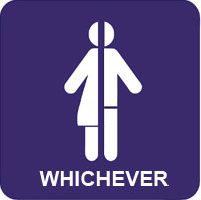F2.4 Accessible Sanitary Facilities
In a building required to be accessible –
The above reference from the 2016 National Construction Code (NCC) Volume One of the Building Code of Australia (BCA), instructs the provision of hygiene facilities fit for use by males and females with disability. The BCA is specific in assigning all accessible sanitary facilities, and in some cases, general facilities, as unisex. In fact, the word ‘unisex’ is mentioned 39 times in the current NCC Volume One of the BCA, mostly when referring to accessible toilets.
The promotion of accessible sanitary facilities for both males and females may be seen as a more equitable and fair provision of toilets, which is, according to the Australian Standards 1428.2-1992, designed for use by people with disabilities who are accompanied by a carer of the opposite sex. However, what happens when the person with disability does not identify themselves as either gender? Or, perhaps, their carer doesn’t either?
People who identify outside of a gender binary can be seen as discriminated against where only male, female, or unisex facilities are available. See a similar article here: https://www.disabilityaccessconsultants.com.au/cant-unisex-ambulant-toilet/
In a recent study conducted by the Journal Park of Recreation Administration (Oakleaf & Richmond, 2017), when exploring the experience of transgender adults and their perceptions of public recreation, participants felt they struggled with cisgender assumptions – societal beliefs that gender identity matches the sex assigned at one’s birth. This often caused negative feelings of fear, isolation, anxiety, and avoidance of public facilities by transgender individuals. Furthermore, public spaces like rest rooms were identified as the most dangerous places, which participants commented as being “scary”.
A particular theme emerged from the above study is of embodying gender, and the difficulties transgender people faced when transitioning between male and female. Some participants only attended leisure facilities that embraced trans-inclusive policies, commenting that not enough public agencies had them.
An alternative, and more inclusive approach to a ‘unisex’ toilet, is one assigned as gender-neutral in both location, design, and associated signage. Governing bodies have a responsibility to provide equitable access to public sanitary facilities. This requires an attitudinal and legislative shift to embrace and advocate a gender-neutral approach, which can be achieved through changes to building codes.

Male, Female & Transgender symbol used on the sign to emphasize users. Is this therefore Inclusive? Or is it applying a stigma to the toilet?
This shift includes an adjustment in language. The BCA contains requirements for Braille and tactile signage in Specification D3.6. Where signs are required, the Australian Standards 1428.1 instructs them to be provided with clear visual, text and Braille representations assigning sanitary facilities to a gender binary – male, female, or unisex.
We believe the provision of toilets where there are no connotations to gender at all is more-inclusive approach for use by any member of the community. This means avoiding the use of gender characters and symbols altogether, and replacing them with visual, text, and Braille representations of, simply, a “toilet”. Our most recent design, shown below, identifies the sanitary facility as being suitable for general use, or for those requiring ambulant or accessible features:
In developing the design for gender-neutral toilet signage our aim was to develop a sign that was clear and easy to understand for everyone, whilst avoiding perceived stigma associated with the facility by classifying it as non-gender specific, and hence being inclusive for all.
We have created two toilet signs without using the word unisex or gender-neutral. In fact, the signage does not nominate any gender or have any other gender identifying features. It simply classifies the facility as a toilet.
We believe using wording such as gender-neutral on signs alters the intent of what the signage needs to achieve: inclusiveness of all people, regardless of whether they associate with a gender.
Our signs simply state ‘Toilet’ or ‘Ambulant Toilet’. The pictograms are for the standard gender-neutral toilet and the addition of stylised crutches defines a gender-neutral Ambulant toilet.
We also propose deleting the Male & Female pictoogram from unisex accessible toilets as we do not believe there is the necessity to emphasize users.
Click on the following link to purchase the Gender Neutral Toilet Signage